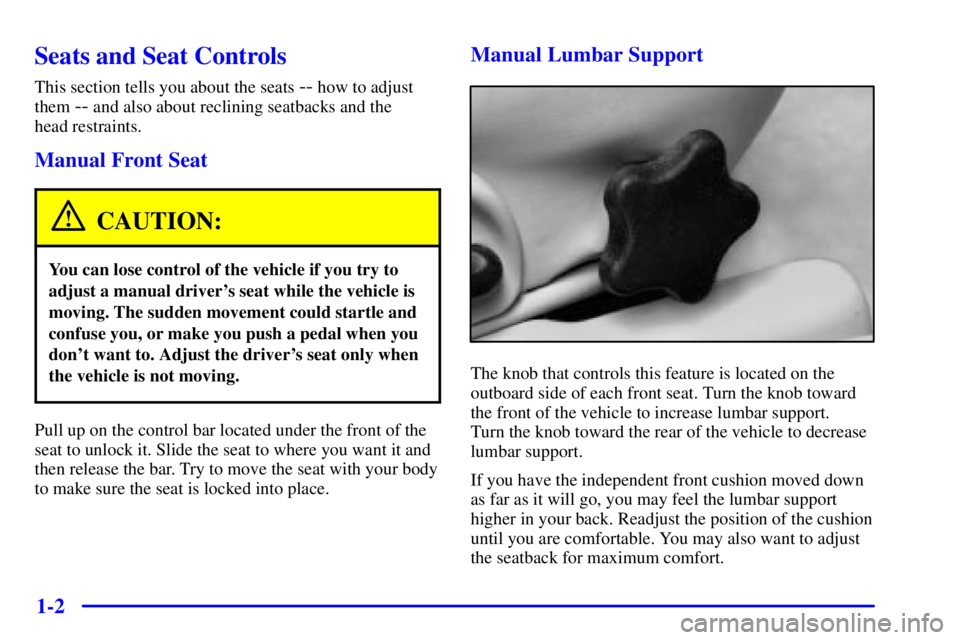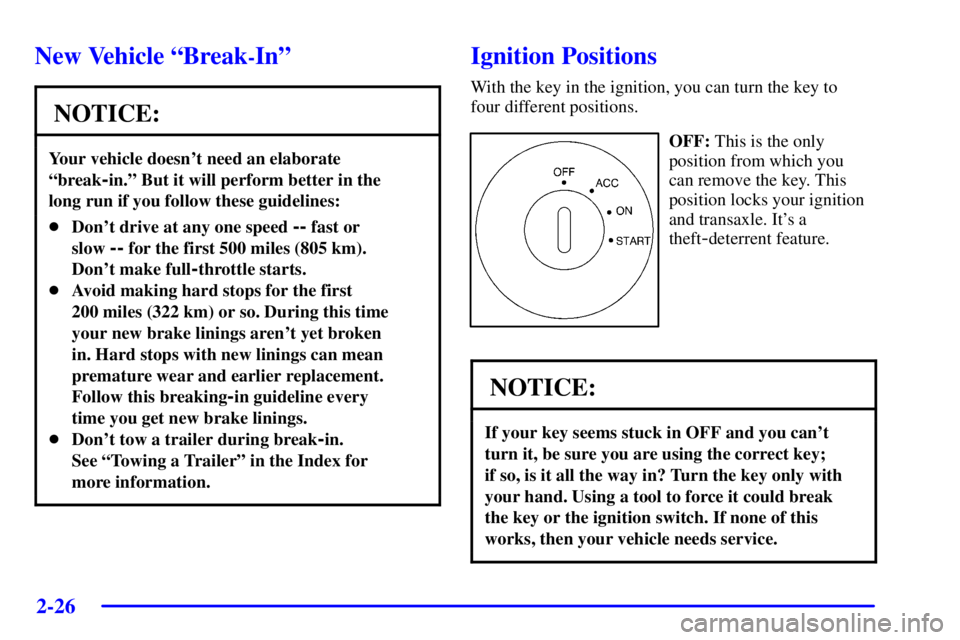Page 8 of 427

1-2
Seats and Seat Controls
This section tells you about the seats -- how to adjust
them
-- and also about reclining seatbacks and the
head restraints.
Manual Front Seat
CAUTION:
You can lose control of the vehicle if you try to
adjust a manual driver's seat while the vehicle is
moving. The sudden movement could startle and
confuse you, or make you push a pedal when you
don't want to. Adjust the driver's seat only when
the vehicle is not moving.
Pull up on the control bar located under the front of the
seat to unlock it. Slide the seat to where you want it and
then release the bar. Try to move the seat with your body
to make sure the seat is locked into place.
Manual Lumbar Support
The knob that controls this feature is located on the
outboard side of each front seat. Turn the knob toward
the front of the vehicle to increase lumbar support.
Turn the knob toward the rear of the vehicle to decrease
lumbar support.
If you have the independent front cushion moved down
as far as it will go, you may feel the lumbar support
higher in your back. Readjust the position of the cushion
until you are comfortable. You may also want to adjust
the seatback for maximum comfort.
Page 9 of 427
1-3 Power Seats (If Equipped)
If your vehicle has this feature, the controls for the
power seats are located on the outboard side of each
front seat.To adjust the power seats, do the following:
Horizontal Control: Raise or lower the front of the seat
cushion by pressing the forward edge of the control up
or down.
Raise or lower the rear of the seat cushion by pressing
the rear edge of the control up or down.
Move the seat forward or rearward by pressing the
control towards the front or rear of the vehicle.
Move the seat higher or lower by holding the whole
control up or down.
Vertical Control (Option): Move the seatback into
a recline position by pressing the top of the control
backward. Move the seatback forward by pressing the
top of the control forward.
Page 33 of 427

1-27
In any particular crash, no one can say whether an air
bag should have inflated simply because of the damage
to a vehicle or because of what the repair costs were.
For frontal air bags, inflation is determined by the angle
of the impact and how quickly the vehicle slows down
in frontal and near
-frontal impacts. For side impact air
bags, inflation is determined by the location and severity
of the impact.
What makes an air bag inflate?
In an impact of sufficient severity, the air bag sensing
system detects that the vehicle is in a crash. For both
frontal and side impact air bags, the sensing system
triggers a release of gas from the inflator, which inflates
the air bag. The inflator, air bag and related hardware
are all part of the air bag modules inside the steering
wheel, instrument panel and the side of the front
seatbacks closest to the door.How does an air bag restrain?
In moderate to severe frontal or near frontal collisions,
even belted occupants can contact the steering wheel or
the instrument panel. In moderate to severe side
collisions, even belted occupants can contact the inside
of the vehicle. The air bag supplements the protection
provided by safety belts. Air bags distribute the force of
the impact more evenly over the occupant's upper body,
stopping the occupant more gradually. But the frontal air
bags would not help you in many types of collisions,
including rollovers, rear impacts, and many side
impacts, primarily because an occupant's motion is not
toward the air bag. Side impact air bags would not help
you in many types of collisions, including frontal or
near frontal collisions, rollovers, and rear impacts,
primarily because an occupant's motion is not toward
those air bags. Air bags should never be regarded as
anything more than a supplement to safety belts, and
then only in moderate to severe frontal or near
-frontal
collisions for the driver's and right front passenger's
frontal air bags, and only in moderate to severe side
collisions for the driver's and right front passenger's
side impact air bags.
Page 47 of 427
1-41
Restraint Systems for Children
An infant car bed (A), a special bed made for use in a
motor vehicle, is an infant restraint system designed to
restrain or position a child on a continuous flat surface.
Make sure that the infant's head rests toward the center
of the vehicle.
A rear-facing infant seat (B) provides restraint with the
seating surface against the back of the infant. The
harness system holds the infant in place and, in a crash,
acts to keep the infant positioned in the restraint.
Page 61 of 427
1-55
CAUTION:
Never do this.
Here two children are wearing the same belt.
The belt can't properly spread the impact forces.
In a crash, the two children can be crushed
together and seriously injured. A belt must
be used by only one person at a time.
Q:What if a child is wearing a lap-shoulder belt,
but the child is so small that the shoulder belt is
very close to the child's face or neck?
A:If the child is sitting in a seat next to a window,
move the child toward the center of the vehicle. If
the child is sitting in the center rear seat passenger
position, move the child toward the safety belt
buckle. In either case, be sure that the shoulder belt
still is on the child's shoulder, so that in a crash
the child's upper body would have the restraint
that belts provide. If the child is so small that the
shoulder belt is still very close to the child's face or
neck, you might want to place the child in a seat
that has a lap belt, if your vehicle has one.
Page 70 of 427
2-7
There are several ways to lock and unlock your vehicle.
If your vehicle has a theft
-deterrent system and it is
activated, unlock the doors only with the key or remote
keyless entry system. This will avoid setting off the
alarm. See ªUniversal Theft
-Deterrentº in the Index for
more information.
To unlock the door from the outside, use your door key
or remote keyless entry transmitter (if equipped).
Turning the door key toward the rear of the vehicle will
unlock the door. Turning the door key toward the front
of the vehicle will lock it.
To lock the door from the inside, push the manual door
lock forward. To unlock the door, push the manual door
lock rearward.
Page 89 of 427

2-26
New Vehicle ªBreak-Inº
NOTICE:
Your vehicle doesn't need an elaborate
ªbreak
-in.º But it will perform better in the
long run if you follow these guidelines:
�Don't drive at any one speed -- fast or
slow
-- for the first 500 miles (805 km).
Don't make full
-throttle starts.
�Avoid making hard stops for the first
200 miles (322 km) or so. During this time
your new brake linings aren't yet broken
in. Hard stops with new linings can mean
premature wear and earlier replacement.
Follow this breaking
-in guideline every
time you get new brake linings.
�Don't tow a trailer during break
-in.
See ªTowing a Trailerº in the Index for
more information.
Ignition Positions
With the key in the ignition, you can turn the key to
four different positions.
OFF: This is the only
position from which you
can remove the key. This
position locks your ignition
and transaxle. It's a
theft
-deterrent feature.
NOTICE:
If your key seems stuck in OFF and you can't
turn it, be sure you are using the correct key;
if so, is it all the way in? Turn the key only with
your hand. Using a tool to force it could break
the key or the ignition switch. If none of this
works, then your vehicle needs service.
Page 93 of 427
2-30
Automatic Transaxle Operation
Your automatic transaxle may have a shift lever
located on the console between the seats or on the
steering column.
There are several
different positions for
your shift lever.
PARK (P): This position locks your front wheels. It's
the best position to use when you start your engine
because your vehicle can't move easily.
CAUTION:
It is dangerous to get out of your vehicle if the
shift lever is not fully in PARK (P) with the
parking brake firmly set. Your vehicle can roll.
Don't leave your vehicle when the engine is
running unless you have to. If you have left the
engine running, the vehicle can move suddenly.
You or others could be injured. To be sure your
vehicle won't move, even when you're on fairly
level ground, always set your parking brake and
move the shift lever to PARK (P).
See ªShifting Into PARK (P)º in the Index.
If you're pulling a trailer, see ªTowing a Trailerº
in the Index.